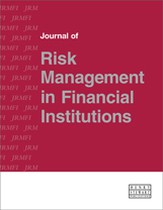Managing differences in economic and regulatory capital: An examination of return of equity (ROE) maximising strategies
Abstract
As per their internal capital adequacy assessment process (ICAAP) and own risk and solvency assessment (ORSA) frameworks, financial institutions (FIs) are subject to both regulatory capital (RC) and economic capital (EC) requirements, the maximum of which becomes the binding constraint, determining the minimum amount of available capital the FI needs to hold. This paper examines alternative strategies and dynamics of the relative RC and EC relationship as FIs seek to maximise return on equity (ROE). The paper shows that EC remains relevant even in cases where RC requirements are higher on aggregate. Under such circumstances FIs are incentivised to ‘dial up’ economic risk by expanding businesses that consume more EC than RC or by divesting businesses consuming more RC than EC in order to enhance ROE. It is explicitly shown that dialling up economic risk lifts up return on EC, boosting ROE. As these opportunities are arbitraged away, EC and RC requirements will tend to converge over time. These strategies, while improving ROE, come at an economic cost. While improving ROE in the short run, low return on EC business may need to be acquired or high return on EC business may need to be divested. The higher the RC relative to EC on aggregate, the higher the potential economic cost. Both the FIs and regulators should prefer EC being the binding constraint on aggregate, supported by strong ICAAP and ORSA frameworks.
The full article is available to subscribers to the journal.
Author's Biography
Bogie Ozdemir is a Vice President in Sun Life Financial Group. He is responsible for economic capital and is building out its capabilities for Solvency II/Own Risk and Solvency Assessment (ORSA) and model validation. Bogie was a Vice President in the BMO Financial Group responsible for economic capital, stress testing and Basel analytics, and jointly responsible for the Internal Capital Adequacy Assessment Process (ICAAP). Previously he was a Vice President in S&P’s Risk Solutions, globally responsible for engineering and implementing new solutions and business development. He has co-authored various papers and a book on Basel II implementation.
Evren Cubukgil is Assistant Vice President of ORSA and Internal Models at Sun Life Financial in Toronto Canada. He focuses on Strategic Risk Management, and Risk and Capital optimisation to enhance ROE. Evren has previously worked on Solvency II ORSA and Operational Risk Modeling in the United Kingdom, on Credit Economic Capital and Stress testing models for ICAAP in Canada and holds a D.Phil in Economics from University of Oxford.
Citation
Ozdemir, Bogie and Cubukgil, Evren (2014, September 1). Managing differences in economic and regulatory capital: An examination of return of equity (ROE) maximising strategies. In the Journal of Risk Management in Financial Institutions, Volume 7, Issue 4. https://doi.org/10.69554/OSRM2705.Publications LLP
